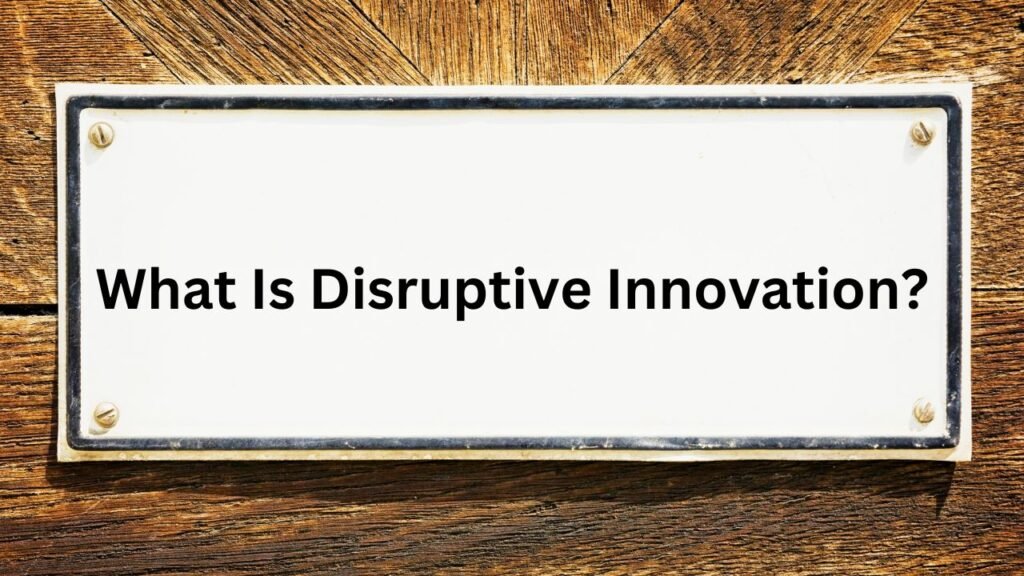Ever heard of disruptive innovation? It’s like the game-changer of all game-changers. It’s not just about doing things differently; it’s about flipping the whole script. This thing isn’t just about bringing in a new gadget or giving an old one a makeover. It’s about totally switching things up, making them better, cheaper, and easier to get. Disruptive innovation isn’t just a makeover; it’s a complete renovation, changing how we live, work, and roll with the world around us.
What Is Disruptive Innovation?
Let’s dive into what disruptive innovation is. It’s like taking those fancy, high-priced goodies and making them budget-friendly for the masses. You know, turning something only the elite could snag into something everyone can grab. It’s like a total game-changer in the market, shoving the old big shots out the door. To put it in simpler terms, it’s like the old saying, “out with the old, in with the new.”

Understanding Disruptive Innovation
You got it! Let’s dig deeper into this whole disruptive innovation thing.
Imagine this: it’s about using the coolest, slickest tech to make stuff available to a bigger crowd. It’s not just a facelift for the same old gang; it’s like throwing the doors open to a whole new crew. Remember when digital music downloads came in and totally flipped the script on CDs? That’s the deal we’re talking about here.
This whole concept got its groove thanks to Clayton Christensen and his game-changing books like “The Innovator’s Solution,” a follow-up to his groundbreaking “The Innovator’s Dilemma” way back in ’97.
Christensen breaks it down into two types of tech for businesses. There’s the stable stuff, letting companies make those expected, gradual improvements to keep up. Then there’s the wild disruptive kind, a whole different animal that can seriously shake things up for companies that aren’t on the ball.
Playing the game of investing in this innovation is no picnic. It’s not just about the tech itself but also about how companies ride the wave.
Check out the internet—companies that didn’t jump on board got left in the dust. And now, with the potential rise of AI potentially taking over jobs, it might throw the job market for a loop real soon.
What’s cool about these game-changers are they’re not just tweaks to existing tech; they bring in totally fresh ways to make bank, often leaving old models in the dust. Think about the shift from laptops to smartphones for everything—browsing, streaming. Phones got savvy with processors and apps that totally flipped the tech game.
What it Takes for Disruptive Innovation
Sure thing! Disruptive innovation is all about causing a ruckus in a good way—getting into those spots that everyone else seems to have missed. It’s like finding the secret ingredient to turn things upside down. To get this game rolling, it’s not just about having a brilliant idea; it’s about getting everyone in on the action. The suppliers, the distributors—they all need to be part of this grand plan.
You’ve got to have that keen eye to spot the spots that have been left out in the cold. It’s about finding those gaps in the market where something new, something game-changing, can step in. Sometimes, it’s not just about creating something entirely from scratch; it could be tweaking what’s already around to fit those gaps that have been overlooked.
But the real power comes from the network. It’s not just about having a killer product; it’s about having everyone on board, from the folks making it to the ones getting it out there. When everyone’s in sync and making the most of this new way of doing things, that’s when the real magic happens. It’s not just about what you’ve got; it’s about how you get it out there and make it work for everyone involved.
Technology that Works its Magic
Let’s talk tech. Enabling technology are like the wizardry in the business realm. It’s all about those groundbreaking inventions that don’t just make things a bit better; they change the whole game. Think of it like the engine behind a speedster—it’s what propels the change. In disruptive innovation, this tech isn’t just any tech; it’s the kind that transforms a product into something more accessible and budget-friendly for a whole new bunch of people.
The key here is speed. How fast this tech gets cooked up and refined determines how quickly it can turn the market on its head. It’s like a race to get this tech out there before someone else beats you to it. But remember, speed isn’t the only game in town. It’s not just about how quickly it happens but how effectively it transforms the market and meets the needs of the people it’s aiming for. It’s a balance between speed and impact. That’s the real magic right there.
Revolutionary Business Style
This new way of doing business? It’s a total game-changer. It’s not just about selling to the big spenders anymore. It’s about flipping the script and reaching out to those who usually get left out—the ones at the bottom. These folks have been out of the picture for the big shots, either ‘cause they couldn’t afford the fancy stuff or it was just too highbrow for their daily grind. This fresh approach, not usually the top pick for the big guns ‘cause of the small profits at the start, aims to dish out simple, wallet-friendly solutions.
This method totally shakes things up. It’s not the same old, same old. It’s a complete game-changer, tapping into a whole new crowd and meeting their needs in a whole new way. It’s like finding a whole new market right under your nose that no one’s paid attention to until now.
Solid Crew for Success
Alright, let’s talk about the squad that makes this disruption work. It’s not just about the disruptors themselves; it’s the whole gang—the suppliers, the distributors, and everyone in between. This gang, the coherent value network, is what brings success to the table. They’re the players both up and down the line, and they all need to be on board for this disruption to hit the jackpot.
These guys might need to shake things up a bit, rearrange stuff to fit this new way of doing business. It’s like shifting puzzle pieces to fit a whole new picture. If everyone isn’t on the same page, the old ways might mess up the whole plan and lead to a total flop. Everyone’s gotta be in sync, working toward the same goal, for this disruption to truly shine. It’s like a team sport—every player counts, and everyone’s gotta play their part to win the game.
Types of Disruptive Innovation
In this online course called Disruptive Strategy, Christensen breaks down the two types of disruptive innovation: low-end and new-market.

Low-End Disruption
Low-end disruption is when a company sneaks into an existing market by offering budget-friendly stuff. They come in at the bottom, grabbing a piece of the pie.
Why’s that a big deal? Well, it’s ‘cause the big shots aren’t all that interested in fighting for the cheapest stuff. They’re all about the big bucks, leaving this lower end wide open for the new kids on the block.
Think about retail medical clinics—places like CVS’s MinuteClinic. They’re not doing heart surgeries; they’re more about dealing with minor issues like a sore throat or an ear infection. These places are super convenient, quick, and cheaper. So, people with these minor issues skip the doctor’s office or the big medical centers and head to these clinics.
Research from the RAND Corporation shows that around 90 percent of visits to these retail clinics are for just 10 common issues, like a sore throat or an ear infection. But get this—those same 10 things only make up 18 percent of visits to regular doctors and just 12 percent of ER visits. These clinics nail these specific issues and do a good job, which makes them the kings of this low-end market.
Now, these clinics aren’t aiming for the big game; they’re not going for the whole buffet of medical services that doctors’ offices or medical centers offer. And because those places make more money with their wider range of services, they’re not exactly eager to compete in this ‘minor issue’ market.
But here’s the kicker: these retail clinics might start offering more specific and fancy services down the road, which might make the big medical centers step back from other market segments. If these clinics keep claiming these specialized and money-making market segments, they could really shake up the whole medical industry.
New-Market Disruption
For sure, let’s break it down in a chill way. So, new-market disruption? That’s when a company swings into an existing market but with a cheaper version of something, aiming at a whole new set of customers.
What makes this one unique is it’s not just about the usual customers—it’s about a brand-new bunch that hasn’t been in the game yet. It’s like rolling out a welcome mat for a fresh crew by offering something that’s easier on the wallet, simple, or just more within reach.
Check this out—think about the transistor radio. Back then, big, fancy stereo systems were ruling the radio scene. They were massive, set up for the living room, and had that top-notch sound.
And then, boom! The portable transistor radio jumps in, brought to the scene by Texas Instruments in ’54. It was small, cheap, and sure, the sound wasn’t top-notch. But here’s the kicker—while those big radios were for the well-off crowd chilling at home, these transistor radios were for a whole different crowd: teens, the budget-conscious bunch, and those on the move.
The fancy radios were all about quality, but the transistor radios promised freedom and accessibility, carving out a totally fresh spot in the radio scene.
But get this—the big shots in the radio biz didn’t see the potential in this new market created by these small radios. They were cheaper, not as big on profits, so they let Texas Instruments take the lead.
As time rolled on, these portable radios got a major upgrade with stuff like the Sony Walkman, MP3 players, iPods, and smartphones. Meanwhile, the demand for those fancy, in-home radio consoles dropped like a rock. Texas Instruments totally shook up the radio scene from the ground up, eventually edging out the big players.
Benefits of Disruptive Innovation
Disruptive innovation is like the secret sauce for a bunch of cool stuff. First off, it’s a game-changer for fresh ideas. When someone rocks the boat with something new, it’s not just about changing how we do things; it’s like opening a treasure chest of new possibilities and cool solutions to problems we didn’t even know we had.
And you know what else? It’s like the cool kid making things more doable for everyone. Disruptive innovations usually mean making stuff cheaper and easier to get, especially for those who couldn’t swing it before. It’s like evening the playing field, giving more folks a shot at top-notch stuff.
Then there’s the big picture. Disruptive innovation isn’t just about one company; it’s like shaking up the whole playground. It makes the big shots step up their game or step aside, making everyone better and keeping the competition spicy.
And guess what? It’s a launchpad for growth. These shake-ups create chances for new businesses, jobs, and entire areas, pumping up the economy and keeping us moving forward. It’s all about pushing us to live, work, and connect in new, awesome ways.
Examples of Disruptive Innovation

Disruptive innovations? The internet takes the cake on that one. When it burst onto the scene, it wasn’t just a tweak here or there, it was a whole new deal. And guess what? It didn’t stop there. It birthed other game-changers like cloud computing, online shopping, and artificial intelligence. It’s like the gift that keeps on giving.
Then, smartphones hit the stage, changing the whole game. Suddenly, everyone had the internet in their pocket, doing all that fancy stuff without needing a fancy computer. They made life easier for folks who couldn’t splash out on laptops or found lugging them around a hassle.
Remember Amazon? They turned book-selling into an online extravaganza, totally changing the game. It was a brand-new move, totally different from the big booksellers like Barnes and Noble.
But hold on, there’s more to the story! Amazon didn’t stop at books. They went all out, selling everything online. Since they set up shop in ’94, they’ve grown into this colossal online giant, making billions in revenue.
And then there’s Netflix, the hero for the online crowd and movie buffs who were kinda left out by big rental companies like Blockbuster. They shook up the industry and sparked off the era of OTT streaming—over the top streaming. That’s how you shake things up, folks. It’s like a domino effect—a whole bunch of disruptions leading to more and more changes.
Disruptive Innovation vs. Disruptive Technology
So, disruptive innovation and disruptive technology might seem like two peas in a pod, but they’re not quite the same gig. Disruptive technology? That’s just about a specific kind of tech, the tech itself. But disruptive innovation? That’s when you take that new tech and use it to shake things up, change the game.
For a tech to be really disruptive, it’s gotta be something brand new, not just a tiny step up from what’s already out there. When we talk about disruptive innovation, it’s not just about that new tech. It needs that tech, plus a fresh business style, and a solid crew backing it up to be the real deal.
Here’s the kicker: disruptive innovation isn’t a one-time thing or just about that one snazzy gadget. It’s a whole process. It’s like when a small company’s thing becomes the next big thing, pushing out what the old big shots used to offer. Those oldies are usually busy tweaking their stuff for their top customers, not really paying attention to the other smaller ones. That’s the cue for the new kids to step in with their fresh ideas and grab a slice of the action. But you know what? It all starts with that disruptive technology. That’s the spark that gets the whole fire going.
Disruptive Innovation vs. Sustaining Innovation
Disruptive innovation is like making things simpler and cheaper for the folks who usually get left out. Big companies are all about making their stuff better for their main customers, not really caring much about the others. This gives a chance for the little guys or newbies to swoop in and give those neglected folks easier and more budget-friendly options.
On the flip side, there’s sustaining innovation. That’s when they work on sprucing up the stuff they already have for their regular customers. It’s not about chasing new markets; it’s just about keeping up with the game. Think about it like CD makers making those discs better, holding more music and tougher to scratch. That’s just making their own thing better.
But when someone shows up with digital downloads online and makes CDs yesterday’s news? That’s the game-changer. They shake things up, totally changing the scene. It’s like waving “bye-bye” to CDs and bringing in a whole new way of doing things.


